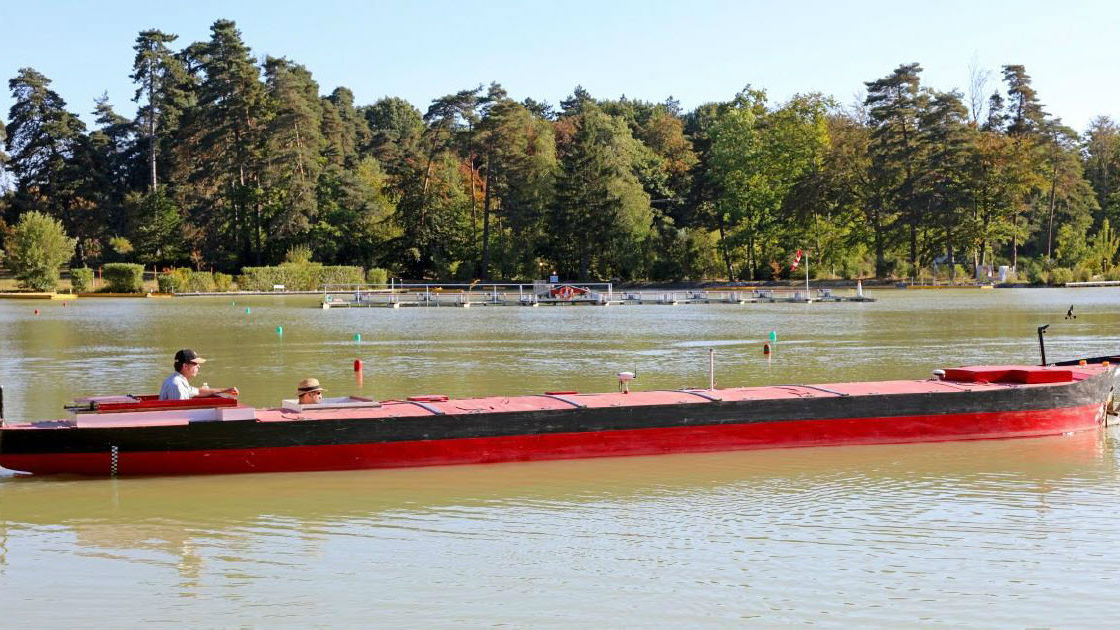Port Revel is the largest and most technical lake-based ship handling training center in the world and has no equivalent in terms of its size and technical installations. Situated on a five hectare lake close to Grenoble, it consists of a physical reproduction of the most dangerous sites for navigation (Cape Horn, etc.), and features a fleet of 11 1:25 scale models of ships, five tugs and a team of instructors and tug pilots.
The team at Port Revel is in direct contact with the maritime sector and follows the technical changes it is undergoing. Because manufacturers of the full-size items needed to build the model ships do not offer scale models, everything, including propellers, pods and rudders, is custom made. With on-site tailoring, the 11 hulls can faithfully simulate 22 ship types, including ferries and ro-ro vessels. To represent different types of propulsion and power ratings, including diesel-electric and steam turbine configurations, the Port Revel engineers reprogram a model’s propulsion system.
The facility is equipped with a wave generator that can create different types of waves, about 40 powerful current generators (up to three knots) and wind generators (up to 30 knots).
Cutting edge electronic equipment is available to record the trajectories of models during the training sessions with pinpoint precision. In addition, the facility features digital navigation simulations with a view to confirming overall layouts of new ports and port extensions designed by Artelia engineering teams.
Service offerings focus on partnerships: special sessions and installations are designed in close collaboration with the trainees. The company can reproduce particular ports and piers at scale for training or test and can customize courses accordingly.
The Port Revel Hydraulics Laboratory develops physical scale models to determine the behavior of moored ships subjected to hydrodynamic forces in conditions that enable numerical models to be validated.
A Tanker First
In 1952, oil company Esso was considering building larger oil tankers for the Gulf-to-Mediterranean route via the Suez Canal, but needed to know beforehand what impact the new-generation ships would have on shipping operations and on the canal’s banks. The Société Grenobloise d’Études Et d’Application Hydraulique (Sogreah) suggested checking their calculations using a scale model of the vessel in a lab setting.
Applying William Froude’s law of similitude, they built a 1:25 model of the proposed 30,000-ton tanker that was accurate in every relevant detail, including hull form, displacement and propeller. The first tests were conducted in a towing tank with the model attached to the towing carriage. The next step was to make the model self-propelled by adding an electric motor scaled according to the same law. Self-propelled models behave in much the same way as the full-size ships they represent.
In 1954, Sogreah went a step further when the team designed a 1:25 model of the Esso France tanker with a seat each for the captain and the helmsman; each with their eyes at the height they would be on the ship itself. In front of them, the key items found on any bridge, including the wheel, rudder angle indicator, compass, anemometer, engine order telegraph and speed and distance log. Captains came from near and far to test the model as all concerned quickly realized how useful the technique would be for training crews and captains under conditions approaching reality.
Next, Esso and Sogreah began looking for a site where they could sail their burgeoning fleet of scale models. They drew a circle 100 kilometers in radius centerd on Grenoble then overlaid a wind map. At Saint-Pierre-de-Bressieux they found a privately owned, two-hectare lake where the wind effects were minimal. In 1966, the partners drained the lake and began reshaping its bed to model the Suez Canal and the approaches to selected ports and harbors, as closely as possible. The idea was to reproduce local bottom effects and familiarize trainees with both the effects and their vessel’s response. Other features were added progressively.
Training Continues
Training exercises in Port Revel’s replica of the Suez Canal began in July 1967, and continue to this day. Sogreah, now known as Artelia, bought Esso’s share of the center in 1970.
Now, over 7,000 ship captains and pilots have participated in training courses on such as berthing, getting underway and overtaking other ships in canals, in a wide range of conditions, involving cross-currents, wind, rudder failure, etc. Over 60 percent of trainees come from North America; others from Russia, Europe and Brazil.
Recently, the Panama Canal authority asked Port Revel to oversee the establishment of its on-site training center using scale models to familiarize pilots with the new locks. According to Artelia, 50 years on, the concept of manned scale model ships continues to demonstrate its efficiency for achieving safe maritime navigation, and a new hull is expected to be commissioned next year.
By MarEx 2017-10-07


















